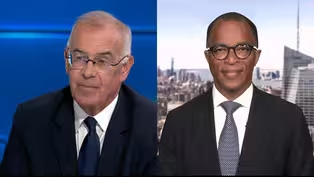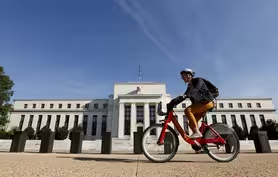
Trump's effort to reshape the White House in his image
Clip: 8/1/2025 | 4m 31sVideo has Closed Captions
A look at Trump's effort to reshape the White House in his image
The Trump administration announced plans for one of the largest renovations to the White House in decades. It includes a 90,000 square foot state ballroom that will be built in the East Wing at a projected cost of $200 million. The White House says donations from President Trump and other private donors will fund it. Geoff Bennett discussed more with Tamara Keith of NPR.
Problems playing video? | Closed Captioning Feedback
Problems playing video? | Closed Captioning Feedback
Major corporate funding for the PBS News Hour is provided by BDO, BNSF, Consumer Cellular, American Cruise Lines, and Raymond James. Funding for the PBS NewsHour Weekend is provided by...

Trump's effort to reshape the White House in his image
Clip: 8/1/2025 | 4m 31sVideo has Closed Captions
The Trump administration announced plans for one of the largest renovations to the White House in decades. It includes a 90,000 square foot state ballroom that will be built in the East Wing at a projected cost of $200 million. The White House says donations from President Trump and other private donors will fund it. Geoff Bennett discussed more with Tamara Keith of NPR.
Problems playing video? | Closed Captioning Feedback
How to Watch PBS News Hour
PBS News Hour is available to stream on pbs.org and the free PBS App, available on iPhone, Apple TV, Android TV, Android smartphones, Amazon Fire TV, Amazon Fire Tablet, Roku, Samsung Smart TV, and Vizio.
Providing Support for PBS.org
Learn Moreabout PBS online sponsorshipGEOFF BENNETT: The White House announced plans for one of the largest renovations of the executive mansion in decades, a 90,000-square-foot state ballroom that will be built in the East Wing of the White House complex.
The cost is some $200 million, with construction set to begin in September.
The White House says it'll be funded by donations from President Trump and other private donors DONALD TRUMP, President of the United States: We have been planning it for a long time.
They have wanted a ballroom at the White House for more than 150 years, but there's never been a president that was good at ballroom.
I'm really good.
GEOFF BENNETT: For more on this, we're joined by Tamara Keith, senior White House correspondent for NPR.
There's never been a president who's been good at ballrooms, President Trump says, Tam.
So what more do we know about this project, how it came to be, and who's been driving this effort behind the scenes?
TAMARA KEITH, National Public Radio: He is driving this effort behind the scenes.
This is something that he has been on a mission to have built all the way back at least until 2010.
I spoke with David Axelrod, who was an adviser to then-President Obama.
He got a call from Donald Trump, then just a man on the outside, offering initially to help with the Deepwater Horizon oil spill, you might remember.
Then, when that was solved, he called back and he said, hey, I can build ballrooms.
You need a ballroom.
These tents are no good.
Typically, state dinners have been held in tents because the largest event space at the White House is the East Room, and it only holds maybe about 200 people seated for dinner.
So Trump called and tried to get Axelrod to let him build a ballroom at the White House.
That didn't work out.
Trump has never forgotten the slight.
And over the last 15 years, he has talked about this repeatedly.
We know now that in the last few months, he's had a number of meetings to get this going.
And he has been very serious, and now it's really happening.
GEOFF BENNETT: And this is the latest in a string of Trump era changes to the White House.
You have got the redesigned Rose Garden.
You have got those towering flagpoles.
You have got the gold accents all over the Oval Office.
How much of this is about aesthetics and how much of it is about branding, the president really trying to put his stamp on the executive mansion itself?
TAMARA KEITH: Yes, the president is putting his stamp on the presidency with his expansive view of executive power.
And he is also very much putting a stamp on the executive mansion, on the White House, all the way down to the medallions above the light fixtures in the Cabinet Room, which he insisted that they have installed because he thought that it just didn't look right before.
He is doing this personally.
It is -- this is a hobby.
He says it gets his builder juices flowing.
And you can't forget that that is where he started.
It's part of his origin story.
And it's clearly something that he is preoccupied with.
GEOFF BENNETT: And the White House says the $200 million price tag will be covered by President Trump and so-called patriot donors.
What kinds of ethical questions does that raise, especially around donor influence?
And then there's a host of potential conflicts of interest.
TAMARA KEITH: Yes, I think we don't have a lot of clarity at this point on who these donors are.
I asked the White House.
They said that they expect them to remain anonymous unless people announce -- they want to announce it themselves.
And it is the case that, with many projects at the White House, it's not funded by the American people.
Many aspects of the upkeep of the White House, the art, the drapery, some of these things, are actually funded by outside groups that are nonprofits that raise money through donations.
GEOFF BENNETT: And the timing is notable because, just last week, the president criticized the Fed chair, Jerome Powell, for what he called luxurious and expensive renovations at the Federal Reserve.
So what kind of transparency can the public expect around this new White House project in terms of the cost and the budget?
TAMARA KEITH: I don't think that the public can expect a lot of transparency.
As we know, with many things involving the White House and the executive branch, no matter the administration, but let's be honest, especially this administration, there just isn't a lot of transparency.
And especially because this is being funded by outside donors and not being paid for by the taxpayers, it's just very hard to get information out of the White House, until 25 years later, when it shows up in the National Archives.
GEOFF BENNETT: Tamara Keith of NPR with us on a Friday night, instead of a Monday, it's always good to see you.
TAMARA KEITH: Good to see you.
Brooks and Capehart on Trump's firing of jobs report chief
Video has Closed Captions
Clip: 8/1/2025 | 11m 5s | Brooks and Capehart on Trump's firing of labor statistics head after weak jobs report (11m 5s)
News Wrap: Federal Reserve governor to resign early
Video has Closed Captions
Clip: 8/1/2025 | 6m 15s | News Wrap: Federal Reserve governor to resign early, giving Trump an opening to fill (6m 15s)
NTSB reveals details on mid-air collision that killed 67
Video has Closed Captions
Clip: 8/1/2025 | 4m 51s | What NTSB hearings revealed about the Washington mid-air collision that killed 67 (4m 51s)
Renowned Pakistani filmmaker on fighting gender inequality
Video has Closed Captions
Clip: 8/1/2025 | 3m 49s | Renowned Pakistani filmmaker on fighting gender inequality (3m 49s)
Tariffs will help improve 'broken' global economy, Cass says
Video has Closed Captions
Clip: 8/1/2025 | 8m 32s | Tariffs will help improve 'broken global economic situation,' economist Oren Cass says (8m 32s)
U.S. whistleblower describes what he saw at Gaza aid sites
Video has Closed Captions
Clip: 8/1/2025 | 13m 23s | Security contractor says he witnessed ‘barbaric’ and un-American tactics at Gaza aid sites (13m 23s)
Providing Support for PBS.org
Learn Moreabout PBS online sponsorshipSupport for PBS provided by:
Major corporate funding for the PBS News Hour is provided by BDO, BNSF, Consumer Cellular, American Cruise Lines, and Raymond James. Funding for the PBS NewsHour Weekend is provided by...

















